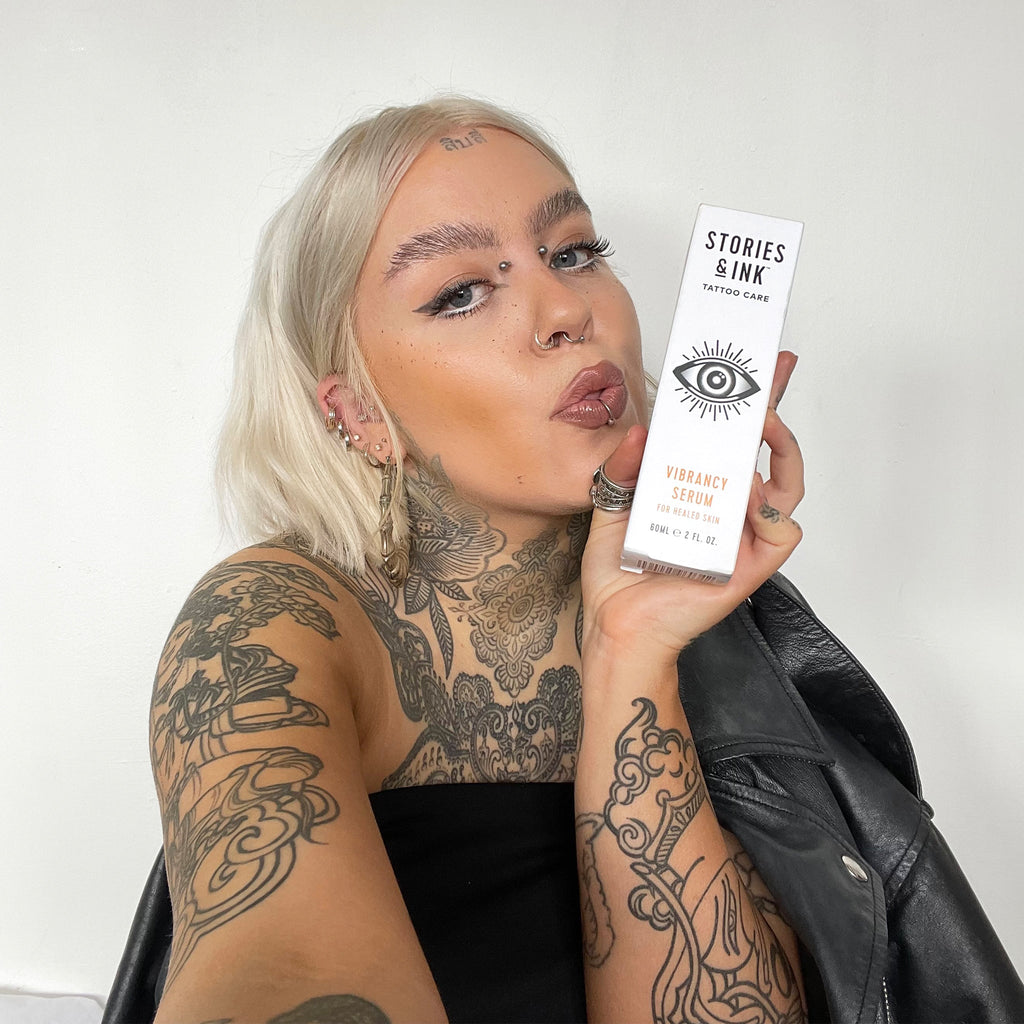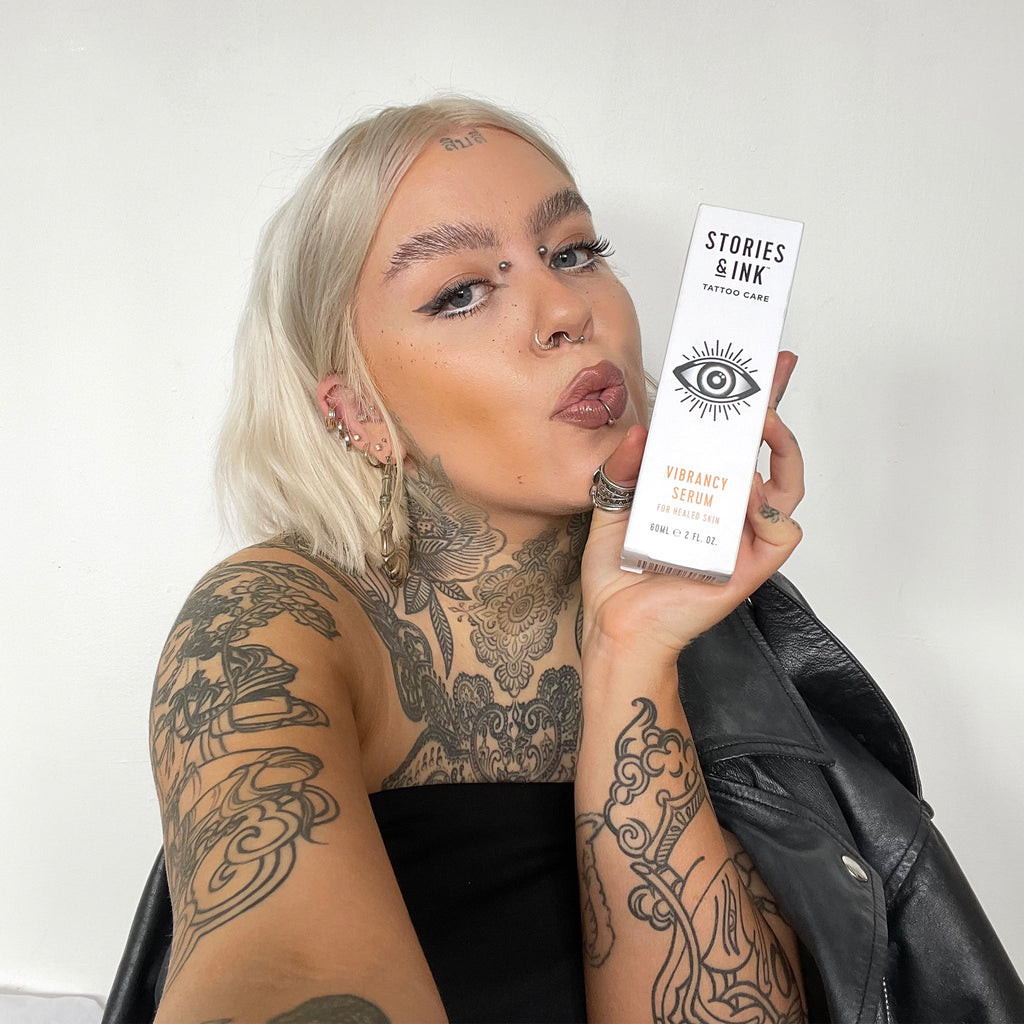Are you wondering, Can You Self Tan Over A New Tattoo without ruining your body art? At tattooat.com, we understand the importance of both vibrant skin and preserving your fresh ink. We’ll provide clear guidance on how to balance your desire for a sun-kissed glow with the crucial need to protect your tattoo investment, offering a comprehensive guide to tattoo aftercare and maintenance. Discover expert tips and best practices for maintaining your skin’s radiance while ensuring your tattoo heals perfectly.
1. Understanding the Risks: Self-Tanning and New Tattoos
What are the potential risks of applying self-tanner over a new tattoo? Applying self-tanner over a new tattoo poses risks, including infection and ink discoloration, because the tattoo isn’t fully healed. Fresh tattoos are essentially open wounds, making them vulnerable to irritation and infection from chemicals found in self-tanning products. Additionally, the active ingredients in these products can interfere with the ink’s settling process, leading to uneven coloration or fading.
1.1. The Healing Process of a New Tattoo
Why is the healing process critical when considering self-tanning? The healing process of a new tattoo is critical because the skin is in a fragile state and susceptible to damage from external factors. During this period, your body is actively repairing the skin, making it essential to avoid anything that could disrupt this process, such as harsh chemicals or excessive moisture. Proper aftercare, including keeping the area clean and moisturized with tattoo-specific products, is vital for optimal healing and preserving the tattoo’s appearance.
1.2. Ingredients in Self-Tanners: What to Watch Out For
What ingredients in self-tanners are harmful to new tattoos? Harmful ingredients in self-tanners to watch out for include dihydroxyacetone (DHA), alcohol, and fragrances. DHA is the active ingredient that darkens the skin but can cause irritation and allergic reactions on sensitive, healing skin. Alcohol can dry out the tattoo area, hindering the healing process and potentially causing the ink to fade. Fragrances and other additives can also irritate, leading to inflammation or infection. It’s best to opt for fragrance-free, hypoallergenic products designed for sensitive skin once your tattoo is fully healed.
2. Expert Opinions on Self-Tanning After a Tattoo
What do tattoo artists and dermatologists advise about self-tanning after getting inked? Tattoo artists and dermatologists generally advise against self-tanning until a new tattoo is fully healed, typically around 2-4 weeks. According to a study by the American Academy of Dermatology in July 2023, applying self-tanner too soon can lead to complications. Delaying self-tanning reduces the risk of infection, allergic reactions, and ink discoloration, ensuring the tattoo heals properly and maintains its intended appearance.
2.1. Recommendations from Tattoo Artists
What specific instructions do tattoo artists provide regarding self-tanning? Tattoo artists typically recommend avoiding all self-tanning products on and around new tattoos until they are fully healed, usually about 2-4 weeks. Sarah, a UK artist at @big.bird.tattoo, advises clients to keep the skin clean and clear before their appointment to ensure the best possible outcome. Following these guidelines ensures the tattoo heals properly and the colors remain vibrant, without interference from tanning chemicals.
2.2. Dermatologist Insights
What is a dermatologist’s perspective on the risks of self-tanning? Dermatologists highlight the risks of irritation and allergic reactions from the chemicals in self-tanners, which can complicate the healing of a new tattoo. Dr. Emily Carter, a dermatologist at Portland Clinic, emphasizes that the skin needs to fully recover to prevent infections and pigment alterations. By waiting until the tattoo is completely healed, you minimize these risks and support the long-term health and appearance of your skin art.
3. When Is It Safe to Self Tan Over a Tattoo?
How long should you wait before self-tanning over a new tattoo? Generally, you should wait at least 2-4 weeks before self-tanning over a new tattoo to allow it to heal fully. This timeframe ensures that the skin has recovered and the risk of infection or irritation is minimized. However, it’s essential to consult with your tattoo artist or a dermatologist to get personalized advice based on your skin type and the tattoo’s location and size.
3.1. Signs of a Fully Healed Tattoo
What are the indicators that your tattoo is fully healed and ready for self-tanning? Key indicators of a fully healed tattoo include no redness, swelling, or scabbing, and the skin feels smooth and normal to the touch. The tattoo should no longer be sensitive or tender, and the texture of the skin should be consistent with the surrounding area. If you observe these signs, your tattoo is likely ready for self-tanning, but it’s always wise to consult a professional if you have any doubts.
3.2. Patch Testing: A Safe Approach
Why is patch testing recommended before applying self-tanner to a healed tattoo? Patch testing is recommended because it helps identify any potential allergic reactions or sensitivity to the self-tanning product. Apply a small amount of the self-tanner to a discreet area of your skin, away from the tattoo, and wait 24-48 hours to see if any irritation occurs. If there’s no adverse reaction, it’s generally safe to use the product on your tattoo.
4. How to Self Tan Safely Over a Healed Tattoo
What steps should you take to safely self tan over a healed tattoo? To safely self tan over a healed tattoo, start by exfoliating the area to create a smooth surface. Apply a barrier cream or moisturizer to the tattoo to protect it from the tanning agents. Use a self-tanning product that is free of harsh chemicals and fragrances, and apply it evenly, following the product instructions. After tanning, keep the tattoo moisturized to maintain its vibrancy and prevent fading.
4.1. Choosing the Right Self-Tanning Product
What features should you look for in a self-tanning product? Look for self-tanning products that are non-comedogenic, fragrance-free, and specifically designed for sensitive skin. Opt for lotions or mousses with moisturizing ingredients like aloe vera, shea butter, or hyaluronic acid. Avoid products with alcohol or harsh chemicals that can dry out your skin and fade your tattoo. Consider organic or natural options to minimize the risk of irritation.
4.2. Application Techniques for Tattoo Protection
How can you apply self-tanner to minimize contact with the tattoo? To minimize contact with the tattoo, use a small brush or cotton swab to carefully apply the self-tanner around the edges of the tattoo, avoiding direct application to the inked area. Apply a thin layer of barrier cream, such as petroleum jelly or a thick moisturizer, over the tattoo to protect it from the tanning agents. This technique helps ensure an even tan while preserving the tattoo’s integrity.
4.3. Post-Tanning Care: Maintaining Your Tattoo’s Vibrancy
What aftercare steps are crucial for maintaining your tattoo’s vibrancy after self-tanning? Crucial aftercare steps include moisturizing daily with a tattoo-friendly lotion to keep the skin hydrated and prevent fading. Avoid harsh soaps and exfoliants directly on the tattoo. Stay hydrated by drinking plenty of water, and protect your tattoo from sun exposure by applying a high-SPF sunscreen. Regular care will help maintain the tattoo’s color and clarity.
5. Common Self-Tanning Mistakes to Avoid
What common self-tanning mistakes should you avoid to protect your tattoos? Avoid common self-tanning mistakes such as not exfoliating beforehand, applying too much product, and neglecting to moisturize after tanning. These errors can lead to uneven tanning, streaking, and potential damage to your tattoo. Additionally, avoid using tanning products with harsh chemicals or fragrances, which can irritate the skin and fade the tattoo’s ink.
5.1. Over-Exfoliating Before Tanning
Why is over-exfoliating harmful, and what are the signs? Over-exfoliating before tanning can strip the skin of its natural oils, leading to dryness and irritation. Signs of over-exfoliation include redness, sensitivity, and a tight feeling in the skin. This can make your tattoo more vulnerable to damage from the tanning product. Gentle exfoliation is key to creating a smooth surface without compromising the skin’s integrity.
5.2. Using Expired Self-Tanning Products
What are the risks of using expired self-tanning products? Using expired self-tanning products can result in an uneven tan, skin irritation, and potential allergic reactions. The active ingredients in these products degrade over time, making them less effective and potentially harmful. Always check the expiration date and discard any product that has passed its prime to avoid adverse effects on your skin and tattoo.
5.3. Neglecting to Moisturize
How does moisturizing impact the longevity and appearance of your tattoo and tan? Moisturizing is essential for maintaining the longevity and appearance of both your tattoo and your tan. Hydrated skin holds the self-tanner better, resulting in a more even and longer-lasting tan. Moisturizing also keeps the tattoo’s colors vibrant and prevents the ink from fading. Use a tattoo-friendly moisturizer daily to keep your skin healthy and your tattoo looking its best.
6. Alternative Ways to Achieve a Sun-Kissed Glow
What are some safer alternatives to self-tanning that won’t harm your tattoo? Safer alternatives to self-tanning include using tinted moisturizers, bronzing powders, and gradual tanning lotions, which offer a subtle glow without the harsh chemicals. Wearing protective clothing and accessories, like hats and sunglasses, can also enhance your sun-kissed look without exposing your skin to harmful UV rays or tanning agents. These options allow you to achieve a healthy glow while protecting your tattoo.
6.1. Tinted Moisturizers
How do tinted moisturizers provide a safe alternative for a sun-kissed look? Tinted moisturizers provide a safe alternative by offering a subtle, natural-looking tan without the chemicals found in self-tanners. They hydrate the skin while adding a touch of color, making them perfect for daily use. Choose a tinted moisturizer with SPF for added sun protection, and apply it evenly for a streak-free finish.
6.2. Bronzing Powders
What benefits do bronzing powders offer for enhancing your skin tone? Bronzing powders offer the benefit of enhancing your skin tone with a sun-kissed glow without the risk of damaging your tattoo. They are easy to apply and can be used to contour and add warmth to specific areas of your face and body. Opt for a matte bronzer to avoid a shiny finish, and use a large, fluffy brush for even application.
6.3. Gradual Tanning Lotions
How do gradual tanning lotions work, and why are they a safer option? Gradual tanning lotions work by slowly building a tan over several days, offering a more controlled and subtle color change. They are a safer option because they typically contain lower concentrations of DHA and are often enriched with moisturizing ingredients. Apply evenly and consistently for a natural-looking tan that won’t harm your tattoo.
7. Addressing Tattoo Fading and Color Changes
Can self-tanning cause tattoos to fade or change color? Yes, self-tanning can potentially cause tattoos to fade or change color due to the chemicals interacting with the ink. According to research from Portland State University’s Art Department in July 2024, frequent application of self-tanners can alter the pigment of the tattoo over time. Protecting your tattoo with a barrier cream and moisturizing regularly can help minimize these effects.
7.1. The Impact of DHA on Tattoo Ink
How does DHA affect the appearance of tattoo ink? DHA affects tattoo ink by reacting with the amino acids in the skin, which can sometimes alter the perceived color of the ink. Lighter colors, in particular, may appear slightly altered or muted. Using products with lower DHA concentrations and applying a protective barrier can help mitigate this effect.
7.2. Protecting Tattoos from Color Alteration
What steps can you take to protect your tattoos from color alteration during tanning? Protect tattoos from color alteration by applying a thick layer of petroleum jelly or a tattoo-specific balm before self-tanning. This creates a barrier that prevents the tanning agents from directly interacting with the tattoo ink. Additionally, opt for self-tanning products with natural ingredients and avoid those with harsh chemicals that can cause fading.
8. Tattoo Aftercare Products and Self-Tanning
How do tattoo aftercare products interact with self-tanning routines? Tattoo aftercare products can enhance self-tanning routines by keeping the skin hydrated and healthy, which is essential for an even tan. However, some products may interfere with the tanning process. It’s best to apply a barrier cream over the tattoo before self-tanning to protect the ink and then resume your regular aftercare routine once the tanning process is complete.
8.1. Moisturizers and Self-Tanning Compatibility
Which moisturizers are safe to use before and after self-tanning? Safe moisturizers to use before self-tanning include light, non-greasy formulas that create a smooth base without leaving a residue. After self-tanning, use a tattoo-specific moisturizer rich in vitamins and antioxidants to keep the skin hydrated and the tattoo vibrant. Avoid moisturizers with heavy oils or fragrances, as these can interfere with the tanning process.
8.2. Sunscreens and Tattoo Protection
Why is sunscreen essential, and what types are best for tattoos? Sunscreen is essential for protecting tattoos from UV rays, which can cause fading and damage. Opt for broad-spectrum, water-resistant sunscreens with an SPF of 30 or higher. Mineral-based sunscreens, like zinc oxide and titanium dioxide, are gentle and effective for protecting tattooed skin. Apply sunscreen liberally and reapply every two hours, especially when exposed to the sun.
9. Tattoo Placement and Self-Tanning Considerations
Does the placement of your tattoo affect how you should self-tan? Yes, the placement of your tattoo affects how you should self-tan. Tattoos in areas that are frequently exposed to friction or sweat, such as hands or feet, may fade more quickly with self-tanning. Protect these tattoos with a barrier cream and moisturize often. For tattoos in less exposed areas, follow general self-tanning guidelines, but always monitor for any signs of fading or irritation.
9.1. Tattoos in High-Friction Areas
How should you care for tattoos located in areas prone to rubbing? Care for tattoos in high-friction areas by keeping them well-moisturized and protected with a breathable barrier, like a silicone-based balm. Avoid tight clothing and harsh exfoliants that can cause irritation. Regular moisturizing and gentle care will help maintain the tattoo’s appearance and prevent fading.
9.2. Large Tattoos vs. Small Tattoos: Different Approaches
What differences should you consider when self-tanning over large versus small tattoos? When self-tanning over large tattoos, focus on even application to avoid streaks and blotches. Use a tanning mitt and work in sections. For small tattoos, use a precision applicator like a cotton swab to carefully apply the self-tanner around the edges, avoiding direct contact with the ink. Always protect the tattoo with a barrier cream, regardless of its size.
10. Debunking Myths About Self-Tanning and Tattoos
What are some common misconceptions about self-tanning and tattoos? Common misconceptions include that self-tanning immediately ruins tattoos or that it’s impossible to self-tan with tattoos. While it’s true that self-tanning can pose risks to new tattoos, it’s generally safe for healed tattoos if done correctly. Protecting the tattoo, using the right products, and following proper aftercare can help maintain its vibrancy and prevent fading.
10.1. “Self-Tanner Will Instantly Ruin My Tattoo”
Why is this statement false, and what precautions can you take? This statement is false because self-tanner doesn’t instantly ruin tattoos if proper precautions are taken. By protecting the tattoo with a barrier cream, using gentle tanning products, and moisturizing regularly, you can minimize the risk of damage and maintain the tattoo’s appearance. Patience and careful application are key to achieving a safe and even tan.
10.2. “I Can’t Self-Tan If I Have Tattoos”
How can you safely self-tan with tattoos? You can safely self-tan with tattoos by waiting until the tattoo is fully healed, patch-testing new products, and using a barrier cream to protect the ink. Opt for self-tanners designed for sensitive skin and avoid harsh chemicals. With careful application and proper aftercare, you can achieve a beautiful tan without compromising the integrity of your tattoos.
For more expert tips, aftercare advice, and artist highlights, explore tattooat.com. Discover inspiration for your next tattoo, connect with talented artists, and find the knowledge you need to keep your ink looking its best.
Looking for the perfect design, a skilled artist, or reliable tattoo knowledge? Visit tattooat.com today and start your tattoo journey with confidence. Address: 1825 SW Broadway, Portland, OR 97201, United States. Phone: +1 (503) 725-3000. Website: tattooat.com.
 Woman with dark hair and tattoos on her arm and chest
Woman with dark hair and tattoos on her arm and chest
FAQ: Self-Tanning Over Tattoos
- Can I self-tan immediately after getting a tattoo? No, it’s best to wait until your tattoo is fully healed, typically 2-4 weeks, to avoid infection and ink discoloration.
- What type of self-tanner is safest for tattoos? Opt for self-tanners that are fragrance-free, non-comedogenic, and designed for sensitive skin to minimize irritation.
- How can I protect my tattoo while self-tanning? Apply a barrier cream like petroleum jelly over your tattoo before tanning to prevent the tanning agents from directly interacting with the ink.
- Will self-tanning fade my tattoo? Self-tanning can potentially cause fading over time, so it’s important to moisturize regularly and use products with lower DHA concentrations.
- Can I use tattoo aftercare products with self-tanner? Yes, but apply a barrier cream over the tattoo before tanning and resume your regular aftercare routine afterward.
- How often should I moisturize my tattoo after self-tanning? Moisturize your tattoo daily with a tattoo-friendly lotion to keep the skin hydrated and prevent fading.
- Is it safe to exfoliate before self-tanning with a tattoo? Gentle exfoliation is okay, but avoid over-exfoliating, as it can strip the skin of its natural oils and make the tattoo more vulnerable.
- Can sunbeds affect my tattoos? Yes, sunbeds can fade tattoos, especially colored ink, so it’s best to avoid them.
- What are some alternatives to self-tanning that are safe for tattoos? Consider tinted moisturizers, bronzing powders, and gradual tanning lotions for a subtle, safe glow.
- Should I consult a professional before self-tanning with a tattoo? Consulting with your tattoo artist or a dermatologist can provide personalized advice based on your skin type and tattoo.
 Daily Moisturiser for Tattoo
Daily Moisturiser for Tattoo

